April 08, 2011
By Christian Berg
One Great Bow. One Terrific Tom. Less Than 24 Hours.
By Christian Berg
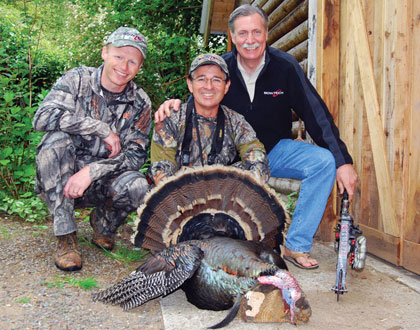 BowTech marketing consultant Jim Velasquez, center, shows off an awesome gobbler he took during an exciting spring 2010 hunt in Douglas County, Ore. Velasquez is flanked by Craig Yehle (left), leader of BowTech's research and development team, and BowTech President Mark Pezzoni. |
As a firm believer in the value of practice and familiarity with your equipment, I don't recommend getting a new bow one day and hunting with it the next.
But as I learned during a May 2010 visit to Oregon, you can do it successfully -- especially when you combine state-of-the-art equipment with a world-class turkey-hunting destination.
Advertisement
My cross-country gobbler getaway came courtesy of the good folks at BowTech, who were eager to show off not only the company's high-tech manufacturing facility but also Oregon's tremendous turkey resource. Although Oregon's turkey-hunting opportunities are relatively unknown compared to legendary destinations such as Texas, Florida and Kansas, I am here to tell you the Beaver State's longbeard action is as good as you can find anywhere.
After a cross-country flight from Philadelphia to Eugene (with a stop in San Francisco), I spent the next day touring BowTech's plant and getting an up-close look at how the company literally builds its BowTech and Diamond bows from solid blocks of aluminum, fiberglass and other materials into the high-end hunting machines customers carry afield. From robotic drills that carve risers and limb pockets from solid aluminum to highly trained craftsmen who laminate limbs to exact performance standards, the BowTech manufacturing operation was truly impressive, and it's not hard to see why the company's products have earned a reputation for innovation and quality.
Advertisement
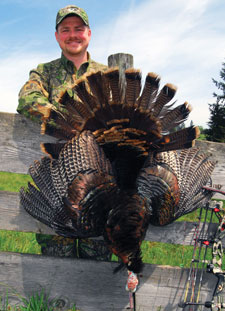 It took BOWHUNTING Editor Christian Berg less than 30 minutes to take this handsome Oregon Rio Grande gobbler during a spring 2010 hunt in Douglas County. The area holds the state's highest concentration of turkeys and is considered one of the top turkey-hunting destinations anywhere west of the Mississippi. |
The highlight of my day was the opportunity to build my own Destroyer 340, which would then be used for a quick turkey hunt an hour outside town in the foothills of the Cascade Mountains. Starting with a box of parts -- and relying on considerable help from BowTech's knowledgeable employees -- I spent a little over an hour moving through the assembly line and emerged at the end with a fully assembled bow that was ready to shoot. Plant workers gleefully noted that it took me more than triple the typical time it takes to build a Destroyer, but who's counting? Personally, I don't think I did half bad for a rookie!
With my new bow assembled, I took it over to BowTech's expansive on-site pro shop, which is open to the public and serves as a hub for the local bowhunting community. There, we added a sight, rest, peep sight and stabilizer and built a dozen arrows. Then, it was a short walk from the work bench over to the indoor shooting range to sight in and see how the new rig felt.
Well, I don't mind telling you the Destroyer felt great in my hand, and within an hour's time, I was easily grouping arrows in the bull's-eye out to 30 yards.
As I said at the beginning of this story, an hour of range time before a hunt is not ideal in my mind, but considering how well the arrows were sailing down range, I was about as confident as I could be under the circumstances.
From Factory to Field
With my new Destroyer dialed in and ready for action, it was time to drive southwest to the small town of Elkton, where we settled into the River Bank Guest House (which is aptly named, as it sits right on the bank of the legendary Umpqua River). From there, our group would fan out into the surrounding countryside in pursuit of the region's robust turkey population.
Perhaps the biggest reason Oregon's turkey hunting is relatively unknown is the fact that turkeys are not native to the state. In fact, it wasn't until 1961 that the state Department of Fish and Wildlife attempted to introduce them with a trap and transfer effort involving the Merriam's subspecies. For whatever reason, those Merriam's never really took off, but a subsequent effort with Rio Grande turkeys in the mid-1970s resulted in great success. So much so, in fact, that turkeys can now be found throughout the state's diverse landscape, with an estimated statewide population of 40,000-50,000 birds. That's more than enough to serve Oregon's 15,000 turkey hunters, who kill a paltry (in terms of its impact on the population) 5,000 birds, on average, each spring.
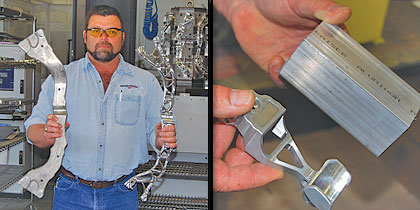 BowTech designs and manufactures its bows at its state-of-the-art headquarters facility in Eugene, Ore. As part of the production process, robotic drills take solid hunks of aluminum and carve them into risers (left) and limb pockets (right). |
Dave Budeau, the state's upland game bird coordinator, said the highest concentration of turkeys in Oregon is found along the I-5 corridor in the southwest portion of the state -- which just so happens to be the area we hunted.
BowTech arranged the hunt with the help of Jody Smith's Guide Service in Elkton, which has been offering guided turkey hunts in the Umpqua Valley for 25 years. Smith said the Elkton-Roseburg-Sutherlin area of Douglas County is known as Oregon's "Golden Triangle" of turkey hunting, with arguably more birds per square mile than anywhere else west of the Mississippi. The area's breathtaking blend of forested hills, farmland woodlots and livestock ranches with spacious hay fields make this game-rich region a haven not only for turkeys but also for Roosevelt elk, blacktail deer, Columbia whitetail deer, cougars and black bears.
"I think there's more turkeys now than there's ever been. In fact, I'm sure of it," said Smith, noting that it is not unusual for his clients to see upwards of 100 birds per day. "But 90 percent of them are on private property. So, it is difficult hunting without accessing private property. It's really good for me, because I am able to pay the landowner a trespass fee and get on some really good areas."
Tu
rkey-hunting regulations in southwest Oregon are quite liberal. The season runs from mid-April through the end of May, and hunters are allowed to take up to three spring birds, with a one-bird daily limit. Better still, tags are available over the counter, so non-resident hunters can simply show up, buy a license and head afield. Smith says his bowhunting clients average 90-percent shot opportunity, with a success rate of about 60 percent. Last spring, Smith's clients (gun and bow) killed 54 birds, of which 20 sported beards measuring 11 inches or longer.
"The numbers are there, and the quality of birds is pretty good," Smith said. "I shot one last year with a 15-inch beard, which is incredible."
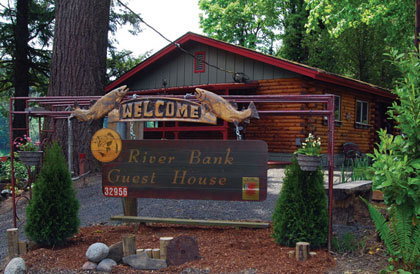 The River Bank Guest House in Elkton, Ore., is nestled along the legendary Umpqua River. The facility's rustic decor, modern amenities and scenic location make it an ideal base for sportsmen exploring the area's hunting and fishing opportunities. |
As for my turkey-hunting experience in Oregon, well, let's just say it turned out short and sweet. After an abbreviated night at the River Bank Guest House, we rose before dawn to meet Smith and his guides at 4:30 a.m. I and another writer were assigned to guide Dave Powell, who had already scouted a productive hay field adjacent to an active roost site and tucked a ground blind into a nearby fence row. Dropping us off at the blind, Powell explained that a large group of birds was roosted in a nearby woodlot and -- if they followed the same script they had in recent days -- was likely to fly down and pass within bow range of our blind on their way to their preferred feeding area.
Anyone who has more than a little turkey-hunting experience knows such scenarios rarely play out according to plan, but on this morning, Powell may as well been controlling the flock from his truck with a remote-control. Even before the sun had climbed above the horizon, the birds were gobbling. And in the fuzzy pink glow of sunrise, we could see black specks slowly working their way in our direction.
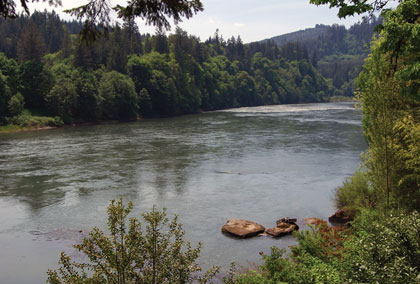 The back deck of the River Bank Guest House in Elkton, Ore., offers spectacular views of the legendary Umpqua River. Bald eagles can often be seen gliding over the water in search of their next meal. |
Although the main group of birds passed about 150 yards out into the field, a straggling 2-year-old tom just couldn't resist the urge to investigate our decoys and the sweet hen music emanating from our blind. After a brief conversation to determine who would take the day's first shot, I drew my brand new bow and unleashed a deadly shaft. Standing over that tom before 7 a.m., with barely 20 minutes of shooting light expired, I felt just a twinge of disappointment that my Oregon turkey hunt was over almost before it began. All the credit belongs to Powell, save for a single, 10-ring accurate shot at 30 yards.
We spent the rest of the day trying to get a gobbler for my hunting partner. Although he didn't tag out, he did get to full draw on three stud gobblers and partake in several other heart-pounding near misses. At one point, Powell and I found ourselves face down in tall grass with no fewer than six gobblers going crazy around us, but our cohort simply couldn't get a shot from his concealed position. To say it was intense would be an understatement!
The following day found me back on a plane. As I headed East at 500 mph, I relived the whirlwind trip in my mind. Yes, my time in Oregon had been a total success. I'd managed to build a great bow and arrow a terrific tom -- all in less than 24 hours. It was an awesome experience, but next time, I think I'll let myself enjoy it just a little bit longer.
Because when it comes to first-class bowhunting gear and terrific turkey hunting, southwestern Oregon is tough to beat.
For more information about turkey hunting in Oregon's Umpqua River Valley, contact Jody Smith's Guide Service at 541-643-6258 or visit www.jodysmithguideservice.com
